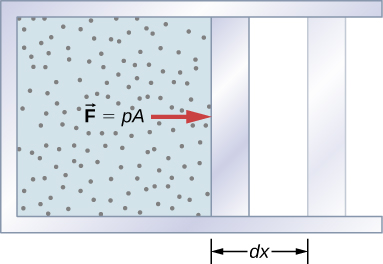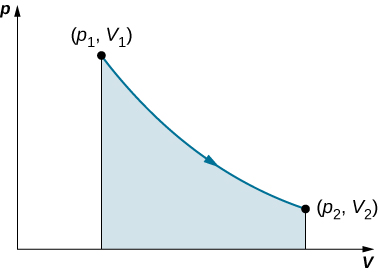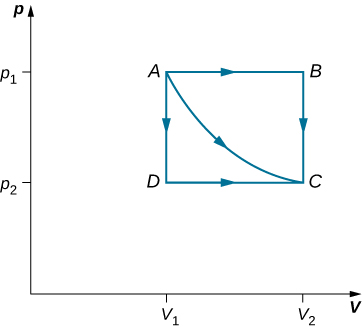Chapter 3 The First Law of Thermodynamics
3.2 Work, Heat, and Internal Energy
OpenStax and Paula Herrera-Siklody
Learning Objectives
- Describe the work done by a system, heat transfer between objects, and internal energy change of a system
- Calculate the work, heat transfer, and internal energy change in a simple process
We discussed the concepts of work and energy earlier in mechanics. Examples and related issues of heat transfer between different objects have also been discussed in the preceding chapters. Here, we want to expand these concepts to a thermodynamic system and its environment. Specifically, we elaborated on the concepts of heat and heat transfer in the previous two chapters. Here, we want to understand how work is done by or to a thermodynamic system; how heat is transferred between a system and its environment; and how the total energy of the system changes under the influence of the work done and heat transfer.
Work Done by a System
A force created from any source can do work by moving an object through a displacement. Then how does a thermodynamic system do work? Figure 3.4 shows a gas confined to a cylinder that has a movable piston at one end. If the gas expands against the piston, it exerts a force through a distance and does work on the piston. If the piston compresses the gas as it is moved inward, work is also done—in this case, on the gas. The work associated with such volume changes can be determined as follows: Let the gas pressure on the piston face be p. Then the force on the piston due to the gas is pA, where A is the area of the face. When the piston is pushed outward an infinitesimal distance dx, the magnitude of the work done by the gas is
Since the change in volume of the gas is
For a finite change in volume from

This integral is only meaningful for a quasi-static process, which means a process that takes place in infinitesimally small steps, keeping the system at thermal equilibrium. (We examine this idea in more detail later in this chapter.) Only then does a well-defined mathematical relationship (the equation of state) exist between the pressure and volume. This relationship can be plotted on a pV diagram of pressure versus volume, where the curve is the change of state. We can approximate such a process as one that occurs slowly, through a series of equilibrium states. The integral is interpreted graphically as the area under the pV curve (the shaded area of Figure 3.5). Work done by the gas is positive for expansion and negative for compression.

Consider the two processes involving an ideal gas that are represented by paths AC and ABC in Figure 3.6. The first process is an isothermal expansion, with the volume of the gas changing its volume from

The expansion is isothermal, so T remains constant over the entire process. Since n and R are also constant, the only variable in the integrand is V, so the work done by an ideal gas in an isothermal process is
Notice that if
The straight lines from A to B and then from B to C represent a different process. Here, a gas at a pressure
From B to C, there is no change in volume and therefore no work is done. The net work over the path ABC is then
A comparison of the expressions for the work done by the gas in the two processes of Figure 3.6 shows that they are quite different. This illustrates a very important property of thermodynamic work: It is path dependent. We cannot determine the work done by a system as it goes from one equilibrium state to another unless we know its thermodynamic path. Different values of the work are associated with different paths.
Example 3.1
Isothermal Expansion of a van der Waals Gas
Studies of a van der Waals gas require an adjustment to the ideal gas law that takes into consideration that gas molecules have a definite volume (see The Kinetic Theory of Gases). One mole of a van der Waals gas has an equation of state
where a and b are two parameters for a specific gas. Suppose the gas expands isothermally and quasi-statically from volume
Strategy
Because the equation of state is given, we can use Equation 3.4 to express the pressure in terms of V and T. Furthermore, temperature T is a constant under the isothermal condition, so V becomes the only changing variable under the integral.
Solution
To evaluate this integral, we must express p as a function of V. From the given equation of state, the gas pressure is
Because T is constant under the isothermal condition, the work done by 1 mol of a van der Waals gas in expanding from a volume
Significance
By taking into account the volume of molecules, the expression for work is much more complex. If, however, we set
Check Your Understanding 3.1
How much work is done by the gas, as given in Figure 3.6, when it expands quasi-statically along the path ADC?
Internal Energy
The internal energy
where the summation is over all the molecules of the system, and the bars over K and U indicate average values. The kinetic energy
In an ideal monatomic gas, each molecule is a single atom. Consequently, there is no rotational or vibrational kinetic energy and
From the discussion in the preceding chapter, we know that the average kinetic energy of a molecule in an ideal monatomic gas is
where T is the Kelvin temperature of the gas. Consequently, the average mechanical energy per molecule of an ideal monatomic gas is also
The internal energy is just the number of molecules multiplied by the average mechanical energy per molecule. Thus for n moles of an ideal monatomic gas,
Notice that the internal energy of a given quantity of an ideal monatomic gas depends on just the temperature and is completely independent of the pressure and volume of the gas. For other systems, the internal energy cannot be expressed so simply. However, an increase in internal energy can often be associated with an increase in temperature.
We know from the zeroth law of thermodynamics that when two systems are placed in thermal contact, they eventually reach thermal equilibrium, at which point they are at the same temperature. As an example, suppose we mix two monatomic ideal gases. Now, the energy per molecule of an ideal monatomic gas is proportional to its temperature. Thus, when the two gases are mixed, the molecules of the hotter gas must lose energy and the molecules of the colder gas must gain energy. This continues until thermal equilibrium is reached, at which point, the temperature, and therefore the average translational kinetic energy per molecule, is the same for both gases. The approach to equilibrium for real systems is somewhat more complicated than for an ideal monatomic gas. Nevertheless, we can still say that energy is exchanged between the systems until their temperatures are the same.
Media Attributions
- Figure 3.4
- Figure 3.5
- Figure 3.6

